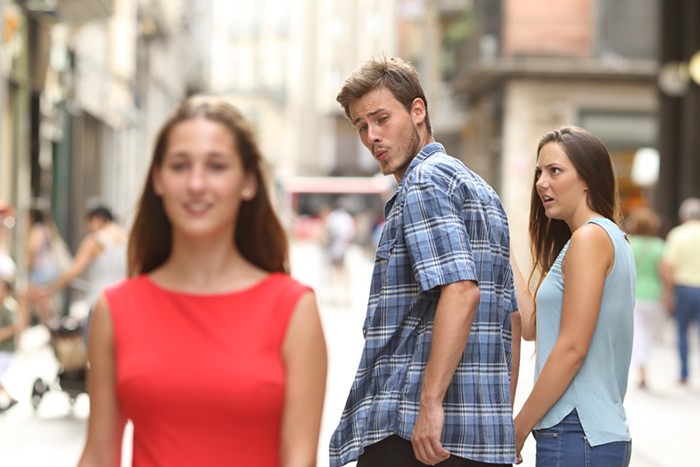If you don’t like self-serious artists, John Baldessari’s your man. A household name in conceptual art, Baldessari’s work exists comfortably in the liminal space between clean abstraction and postmodern critique. His pieces tend to be dryly funny, or simply weird, and if you ever get a chance to see them in real life, you should take it. We’re in luck this month, with Madame Cézanne’s Hairdos at Elizabeth Leach Gallery. The title is a literal one: The show features a series of tricolor screenprints of a woman’s forehead, with her hair arranged slightly differently in each one, and titles like “Rhomboid” and “Pyramid” nodding at the shape of each vaguely representational image.
As a sight gag and as a joke at the expense of portraiture, poorly-cropped snapshots, or conceptual art itself, the series is funny and light. It reminds me of previous Baldessari projects, like the ones collected in Pure Beauty, a retrospective of the artist’s work that landed at New York’s Met in 2010, and included such delights as Baldessari’s collage pieces, ironic text paintings offering instructions for selling your work, and I Will Not Make Any More Boring Art, in which Baldessari repeatedly Bart Simpson’d that sentence on paper; it was a gesture that New York Magazine’s Jerry Saltz said “every artist ought to be required to make once in his or her life.” I couldn’t agree more.
Why am I describing a show that’s long over, that you won’t see, and that didn’t come to Portland? Because there’s a huge difference between a giant retrospective and a small gallery display—while the former provides plenty of context to newcomers, the latter does not. And though I’m a fan of Baldessari’s work, even I have reservations about recommending that you go out of your way to see a slight show that includes only one print series, even one this visually clever. So if you’re new to Baldessari, arming yourself with a preemptive Google image search isn’t a bad idea. It’s also fortunate that Elizabeth Leach’s adjacent New Modernism show, featuring work from Math Bass, Pat Boas, Chris Gander, Chris Johanson, Samuel Levi Jones, Joanna Pousette-Dart, and Amanda Wojick, is also worth seeing—particularly Pousette-Dart’s works in acrylic on panel, their large gestures and bright color scheme evoking such disparate points of reference as Sonia Delaunay’s geometric paintings and pop art’s neon precision.
Much of conceptual art isn’t particularly accessible, making it the upper limit of art appreciation unless you’re someone who actually studies or makes it. But some conceptual artists—the ones I think are actually the most interesting—can draw in a casual viewer through clever uses of scale or nods at the process itself. With his large-scale wall drawings, Sol LeWitt comes to mind immediately as one of these artists. So does Barbara Kruger, whose text work was some of the first conceptual art I was exposed to. But neither of these artists quite equals the same humorous, picaresque sensibility of John Baldessari. That’s why I think his work is worth seeing—because if you’re willing to take a chance on conceptual art, it’s likely he’ll reward that effort.













